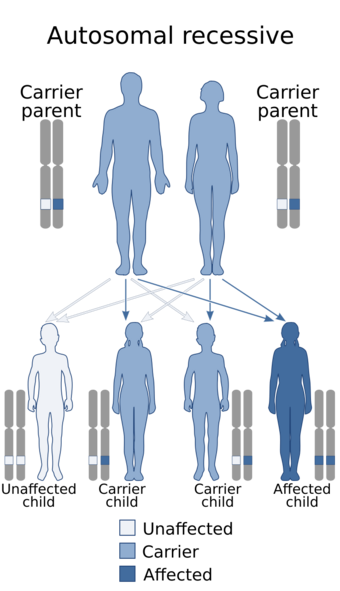Medicine:Bare lymphocyte syndrome type II
| Bare lymphocyte syndrome type II | |
|---|---|
| Other names | HLA class 2-negative severe combined immunodeficiency, HLA Class 2-Negative |
 | |
| Bare lymphocyte syndrome 2 is autosomal recessive in inheritance | |
| Symptoms | Neutropenia[1] |
| Causes | Absence of human leukocyte antigen class II expression [1] |
| Diagnostic method | Genetic test[1] |
| Medication | Bone marrow transplant[2] |
Bare lymphocyte syndrome type II (BLS II) is a rare recessive genetic condition in which a group of genes called major histocompatibility complex class II (MHC class II) are not expressed.[3][4] The result is that the immune system is severely compromised and cannot effectively fight infection.
Symptoms and signs
Among the signs and symptoms that Bare lymphocyte syndrome type II exhibits are the following:[1][5]
- Chronic mucocutaneous candidiasis
- Colitis
- Recurrent bacterial infections
- Encephalitis
- Neutropenia
- Diarrhea
- Hepatitis(viral)
- Growth abnormality
Cause
The genetic cause of Bare lymphocyte syndrome type II is due to mutations in any of the following genes:[5]
- CIITA is responsible for giving instructions to create a protein that controls transcription of genes (MHC class II), and is located at 16p13.13 (cytogenetic location),[6]
- RFX5 has the same function(as prior gene) and is located at 1q21.3(cytogenetic location)[7]
- RFXANK(also known as ankyrin repeat-containing regulatory factor X-associated protein) has the same function(as the other genes) and is located at 19p13.11(cytogenetic location)[8]
- RFXAP gives information to create RFX associated protein, which also is involved in transcription of MHC class II genes, and is located at 13q13.3,(cytogenetic location)[9]
Mechanism
Major histocompatibility complex class II proteins are important because under normal function they have important responsibility in the human body's immune system response. MHC II proteins present exogenous antigens that activate CD4+ T-lymphocytes, immune cells that are responsible for activating other immune cells like CD8+ T-lymphocytes and macrophages.[10] MHC II proteins are also important for positive and negative selection in the thymus because they present antigens to immature T-cells, allowing the T cells to differentiate into proper functioning CD4+ T-lymphocytes. This may explain why patients with BLS II display decreased levels of CD4+ T-lymphocytes in their blood.[11]
The basis for BLSII is not due to defects in the MHC II genes themselves, it is the result of mutations in genes that code for proteins, transcription factors that normally regulate the expression of the MHC II genes. One of the several proteins that are required to switch on MHC II genes in various cells types is absent. [5]
Diagnosis
The diagnosis for Bare lymphocyte syndrome type II can be done via genetic testing[12] A blood test could indicate decreased CD4+ T-cells(T-helper lymphocyte), as well as serum immunoglobulin[2]
Management
In terms of treatment for major histocompatibility complex class II deficiency(Bare lymphocyte syndrome type II), one finds that according to Matheux, et al. a possible treatment for this condition might be found in cellular and gene therapy[13] The prognosis is poor (without treatment) in early childhood for this condition;[14][2] additional treatment options include anti-microbial prophylaxis prior to bone marrow transplant[2][15]
See also
References
- ↑ 1.0 1.1 1.2 1.3 "Bare lymphocyte syndrome 2 | Genetic and Rare Diseases Information Center (GARD) – an NCATS Program" (in en). https://rarediseases.info.nih.gov/diseases/824/bare-lymphocyte-syndrome-2.
- ↑ 2.0 2.1 2.2 2.3 al.], Stephan Strobel ... [et; Smith, Peter K. (2006) (in en). Paediatrics and Child Health the Great Ormond Street Handbook.. London: Manson Pub.. p. 465. ISBN 9781840765625. https://books.google.com/books?id=prdAvy5c4goC&q=major+histocompatibility+complex+class+II+deficiency+diagnosis&pg=PA465. Retrieved 28 July 2017.
- ↑ "OMIM Entry - # 209920 - BARE LYMPHOCYTE SYNDROME, TYPE II" (in en-us). https://omim.org/entry/209920.
- ↑ Reference, Genetics Home. "bare lymphocyte syndrome type II" (in en). https://ghr.nlm.nih.gov/condition/bare-lymphocyte-syndrome-type-ii#synonyms.
- ↑ 5.0 5.1 5.2 "SCID due to absent class II HLA antigens (Concept Id: C0242583) - MedGen - NCBI". https://www.ncbi.nlm.nih.gov/medgen/69211.
- ↑ Reference, Genetics Home. "CIITA gene" (in en). https://ghr.nlm.nih.gov/gene/CIITA.
- ↑ Reference, Genetics Home. "RFX5 gene" (in en). https://ghr.nlm.nih.gov/gene/RFX5#location.
- ↑ Reference, Genetics Home. "RFXANK gene" (in en). https://ghr.nlm.nih.gov/gene/RFXANK.
- ↑ Reference, Genetics Home. "RFXAP gene" (in en). https://ghr.nlm.nih.gov/gene/RFXAP#location.
- ↑ Reith, Walter; Picard, Capucine (2016). "Major Histocompatibility Complex Class II Deficiency". Academic Press 5: 378–390. https://www.sciencedirect.com/science/article/pii/B9780123742797180051. Retrieved 4 December 2020.
- ↑ DeSandro, Angela; Nagarajan, Uma; Boss, Jeremy (September 2017). "Associations and Interactions between Bare Lymphocyte Syndrome Factors". Molecular and Cellular Biology 20 (17): 6587–6599. doi:10.1128/mcb.20.17.6587-6599.2000. PMID 10938133.
- ↑ "Bare lymphocyte syndrome type 2, complementation group A - Conditions - GTR - NCBI" (in en). https://www.ncbi.nlm.nih.gov/gtr/conditions/C1859534/.
- ↑ Matheux, Franck; Villard, Jean (June 2004). "Cellular and gene therapy for major histocompatibility complex class II deficiency". News in Physiological Sciences 19 (3): 154–158. doi:10.1152/nips.01462.2003. ISSN 0886-1714. PMID 15143213.
- ↑ RESERVED, INSERM US14 -- ALL RIGHTS. "Orphanet: Immunodeficiency by defective expression of HLA class 2" (in en). http://www.orpha.net/consor/cgi-bin/OC_Exp.php?Lng=EN&Expert=572.
- ↑ Bratzler, Dale W.; Dellinger, E. Patchen; Olsen, Keith M.; Perl, Trish M.; Auwaerter, Paul G.; Bolon, Maureen K.; Fish, Douglas N.; Napolitano, Lena M. et al. (February 2013). "Clinical practice guidelines for antimicrobial prophylaxis in surgery". Surgical Infections 14 (1): 73–156. doi:10.1089/sur.2013.9999. ISSN 1557-8674. PMID 23461695. https://deepblue.lib.umich.edu/bitstream/2027.42/140217/1/sur.2013.9999.pdf.subscription needed
Further reading
- "The bare lymphocyte syndrome and the regulation of MHC expression". Annu. Rev. Immunol. 19: 331–73. 2001. doi:10.1146/annurev.immunol.19.1.331. PMID 11244040. Review
- Ting, Jenny Pan-Yun; Trowsdale, John (April 2002). "Genetic Control of MHC Class II Expression" (in en). Cell 109 (2): S21–S33. doi:10.1016/S0092-8674(02)00696-7. ISSN 0092-8674. PMID 11983150.
External links
| Classification | |
|---|---|
| External resources |
 |



